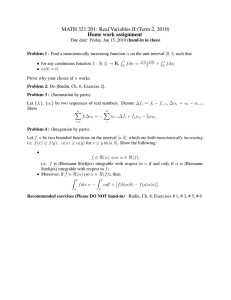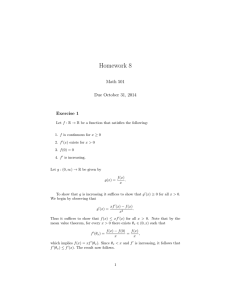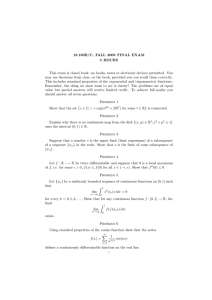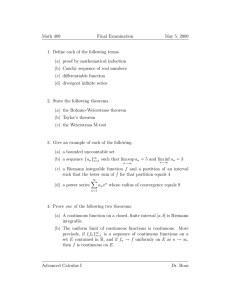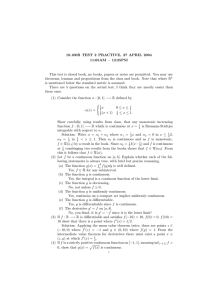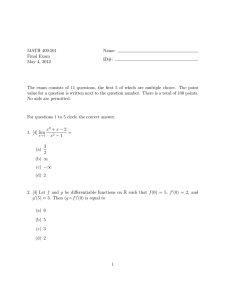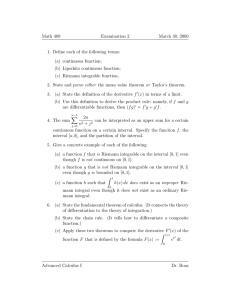18.100B, FALL 2002 IN-CLASS TEST 2: NOVEMBER 12
advertisement
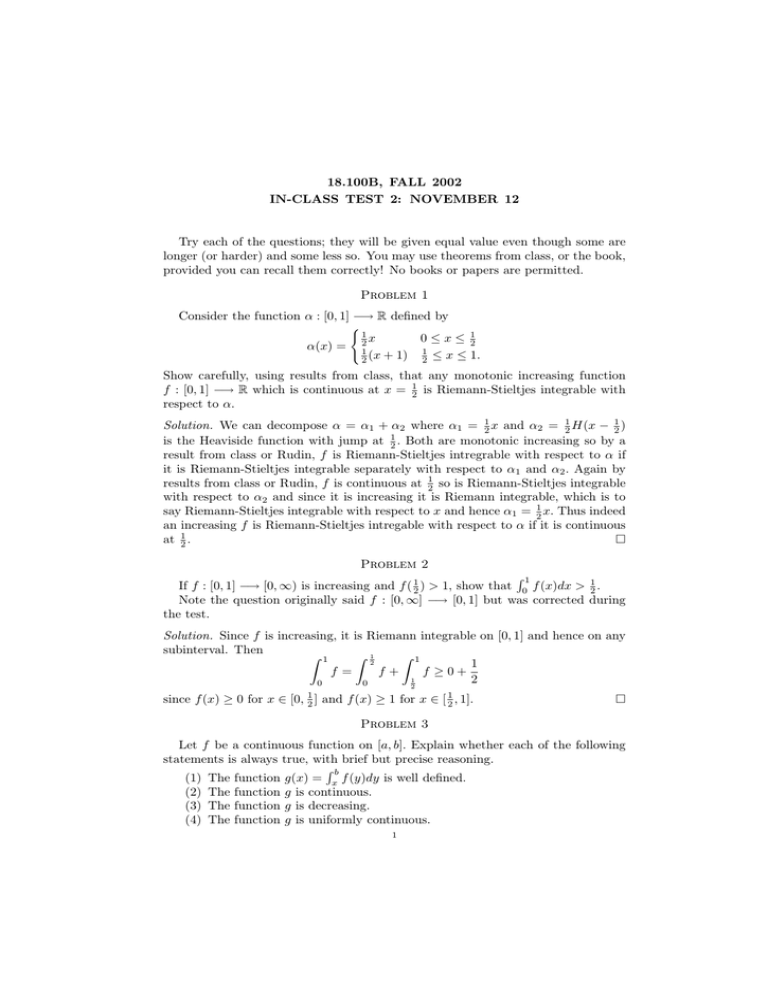
18.100B, FALL 2002 IN-CLASS TEST 2: NOVEMBER 12 Try each of the questions; they will be given equal value even though some are longer (or harder) and some less so. You may use theorems from class, or the book, provided you can recall them correctly! No books or papers are permitted. Problem 1 Consider the function α : [0, 1] −→ R defined by ( 1 x 0 ≤ x ≤ 12 α(x) = 21 1 2 (x + 1) 2 ≤ x ≤ 1. Show carefully, using results from class, that any monotonic increasing function f : [0, 1] −→ R which is continuous at x = 12 is Riemann-Stieltjes integrable with respect to α. Solution. We can decompose α = α1 + α2 where α1 = 12 x and α2 = 12 H(x − 12 ) is the Heaviside function with jump at 12 . Both are monotonic increasing so by a result from class or Rudin, f is Riemann-Stieltjes intregrable with respect to α if it is Riemann-Stieltjes integrable separately with respect to α1 and α2 . Again by results from class or Rudin, f is continuous at 12 so is Riemann-Stieltjes integrable with respect to α2 and since it is increasing it is Riemann integrable, which is to say Riemann-Stieltjes integrable with respect to x and hence α1 = 12 x. Thus indeed an increasing f is Riemann-Stieltjes intregable with respect to α if it is continuous at 21 . Problem 2 R1 If f : [0, 1] −→ [0, ∞) is increasing and f ( 12 ) > 1, show that 0 f (x)dx > 12 . Note the question originally said f : [0, ∞] −→ [0, 1] but was corrected during the test. Solution. Since f is increasing, it is Riemann integrable on [0, 1] and hence on any subinterval. Then Z 1 Z 12 Z 1 1 f= f+ f ≥0+ 1 2 0 0 2 since f (x) ≥ 0 for x ∈ [0, 12 ] and f (x) ≥ 1 for x ∈ [ 12 , 1]. Problem 3 Let f be a continuous function on [a, b]. Explain whether each of the following statements is always true, with brief but precise reasoning. Rb (1) The function g(x) = x f (y)dy is well defined. (2) The function g is continuous. (3) The function g is decreasing. (4) The function g is uniformly continuous. 1 2 18.100B, FALL 2002 IN-CLASS TEST 2: NOVEMBER 12 (5) The function g is differentiable. (6) The derivative g 0 = f on [a, b]. Rb Note: The ambiguous notation x f (x)dx was corrected during the test. Solution. (1) Since f is continuous on [a, b] it is continuous on [x, b] for any Rb x ∈ [a, b] and so is Riemann integrable and g(x) = x f (y)dy is well defined. (2) Yes, this is a result from class that the integral of any integrable function depends continuously on the endpoint. In fact we only did it for the upper Rb Rx end point but g(x) = a f − a f so it follows for the lower end point. (3) No, the integral could be increasing as x increases if f were negative for instance. (4) Yes. Either directly by estimating the integral or because any continuous function on a compact set is uniformly continuous. (5) Yes, the the function g is differentiable at any point of continuity of the Rx integrand since, by a result (the FTC) from Rudin/class, a f is differenRb Rx tiable and hence so is g(x) = a f − a f (there is no need really to say this since I did point out in class that the integral was differentiable with respect to the lower limit.) Rx (6) No, the derivative is g 0 = −f on [a, b] since g 0 is the derivative of − a f which is −f by the fundamental theorem of calculus. Problem 4 (1) If f is a strictly positive continuous function on [−1, 1], meaning inf [−1,1] f > p 0, show that g(x) = f (x) is continuous. (2) Suppose f is twice continuously differentiable on [−1, 1]. Show that f (x) = c0 + c1 x + c2 x2 g(x) for some continuous function g on [−1, 1]. Hint: Decide what c0 and c1 must be and then define g(x) = (f (x) − c0 − c1 x)/x2 , x 6= 0. Decide what g(0) should be and check continuity away from 0 and at 0 separately. (3) Suppose f is twice continuously differentiable on [−1, 1] and f (0) = f 0 (0) = 0 but f 00 (0) = 1. Show that there is a continuous function h on [−1, 1] such that f (x) = (xh(x))2 on [−1, 1]. Again I had to correct several typos. I added that the functions g in the first and second parts were not (necessarily) related AND I added that f ≥ 0 in the last part. I had really meant to have f ≥ 0 and f (x) > 0 for x 6= 0. Solution. (1) This follows from a result in Rudin/class showing that φ ◦ f is continuous if f is continuous √ and φ is continuous on the range of f. In this case we can take φ(t) = t on [0, ∞). I don’t mind you assuming √ √that this is continuous, it is easy enough to show since if t, s ≥ 0 then t, s ≥ 0 so √ √ √ √ √ √ √ √ t+ s ≥ | t− s| and |t−s| ≤ 2 implies | t− s| = |t−s|/( t+ p s) ≤ (unless t = s = 0 in which case it is true anyway). Thus g(x) = f (x) is continuous. 18.100B, FALL 2002 IN-CLASS TEST 2: NOVEMBER 12 3 2 (2) By Taylor’s theorem f (x) = f (0) + xf 0 (0) + x2 f 00 (y) for some y ∈ (0, x) or (x, 0) as x > 0 or x < 0. Thus we should take c0 = f (0) and c1 = f 0 (0). Then define ( f (x)−f (0)−xf 0 (0) 0 6= x ∈ [−1, 1] x2 g(x) = 00 f (0)/2x = 0 Now, for x 6= 0 this is continuous because it is the quotient of one continuous function by another. At 0 it is continuous by Taylor’s theorem, since f 00 is continuous at 0 and so given > 0 there exists δ > 0 such that |y| ≤ δ implies |f 00 (y) − f 00 (0)| ≤ so if |x| < δ then 1 |g(x) − g(0)| = |f 00 (y) − f 00 (0)| < 2 shows the continuity of g. (3) Now we have c0 = c1 in the previous case and f ≥ 0. This implies that g(x) ≥ 0 for x 6= 0 and we are given that g(0) = 12 f 00 (0) > 0 so g ≥ 0 everywhere (in fact it follows by continuity so this is rather a red herring!). Now, we can apply what we did in the first part to see that g = h2 for some continuous h (I know, it should have said only f ≥ 0 in the first part so as not to be so confusing) and then f (x) = (xh(x))2 as claimed. I said anyone who made a reasonable effort at the last part should get full marks for it because of the confusion.
